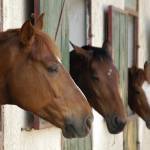Dust in Horse Barns: Feeds and Bedding Contribute

Respirable dust in horse barns may contain a mixture of small particles including bits of soil, mold spores, feed, hay, and bedding. When they are inhaled, these particles might cause airway inflammation that is sometimes severe enough to impact free breathing and limit the horse’s ability to exercise.
Research* conducted at the University of Sydney was designed to determine the level of total and respirable particles and endotoxin concentrations in several types of feed and bedding. A horse’s exposure to breathable particles was tested six times for each individual feed (oats, hay, chaff, and pellets) and type of bedding (shavings, sawdust, rice hulls, and straw). Averages were then obtained for total and respirable particles and particle endotoxin concentrations when horses were exposed to each combination of one feed and one bedding material.
Rice hull bedding had the highest level of total and respirable particles. Straw bedding had the highest concentration of respirable endotoxins. All tested feeds were similar in total and respirable particles and endotoxin concentrations. Results suggested that regardless of feed and bedding choices, the breathing zones of horses may potentially contain very high levels of respirable particles and endotoxins.
*“Exposure of horses to total and respirable particle endotoxin concentrations generated by specific feed and bedding materials” was presented at the 2006 Australian Equine Science Symposium.








